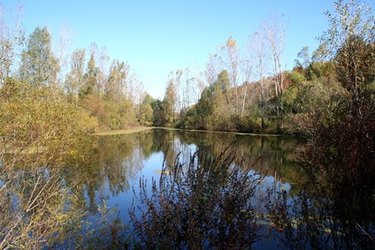
Hydrilla is a plant that infests lakes and other bodies of water, growing rapidly and overtaking the waterway if left unchecked. Hydrilla is notoriously difficult to control and eradicate without serious chemical herbicides; however, there are ways you can remedy hydrilla at home without spraying dangerous chemicals. Hydrilla reproduces quickly, choking up the oxygen supply and hindering aquatic life. For both environmental and aesthetic purposes, it is beneficial to get rid of hydrilla before it gets out of control.
Step 1
Pull up hydrilla plants by hand at first sight. Tearing the plants out by the roots discourages new growth and prevents the hydrilla from spreading. If hydrilla is a problem, monitor the lake or pond frequently, plucking out any new growth.
Video of the Day
Step 2
Drag the bottom of the pond with a boat-mounted chain and metal or wooden grid to pull up deeper roots and plant growth.
Step 3
Drain the pond if it is easy to do without killing the other plant and aquatic life. For smaller or decorative ponds, this is an effective way to expose the hydrilla growth to sunlight. While sunlight promotes hydrilla growth in water, removing the water will dry it out. Without moisture, the plant will wither and die in the sunlight.
Step 4
Line the bottom of the pond or lake with plastic sheeting or lining to discourage future growth of hydrilla and other invasive plant species. Thick and opaque plastic lining prevents sunlight penetration and hinders hydrilla growth on the water floor.
Tip
Contact your local environmental agency for assistance with managing hydrilla. As the plant is considered an invasive species, there may be programs in place to help citizens with their hydrilla problems.
Warning
Hydrilla is becoming increasingly resistant to chemical herbicides, so don't depend solely on those.
Video of the Day